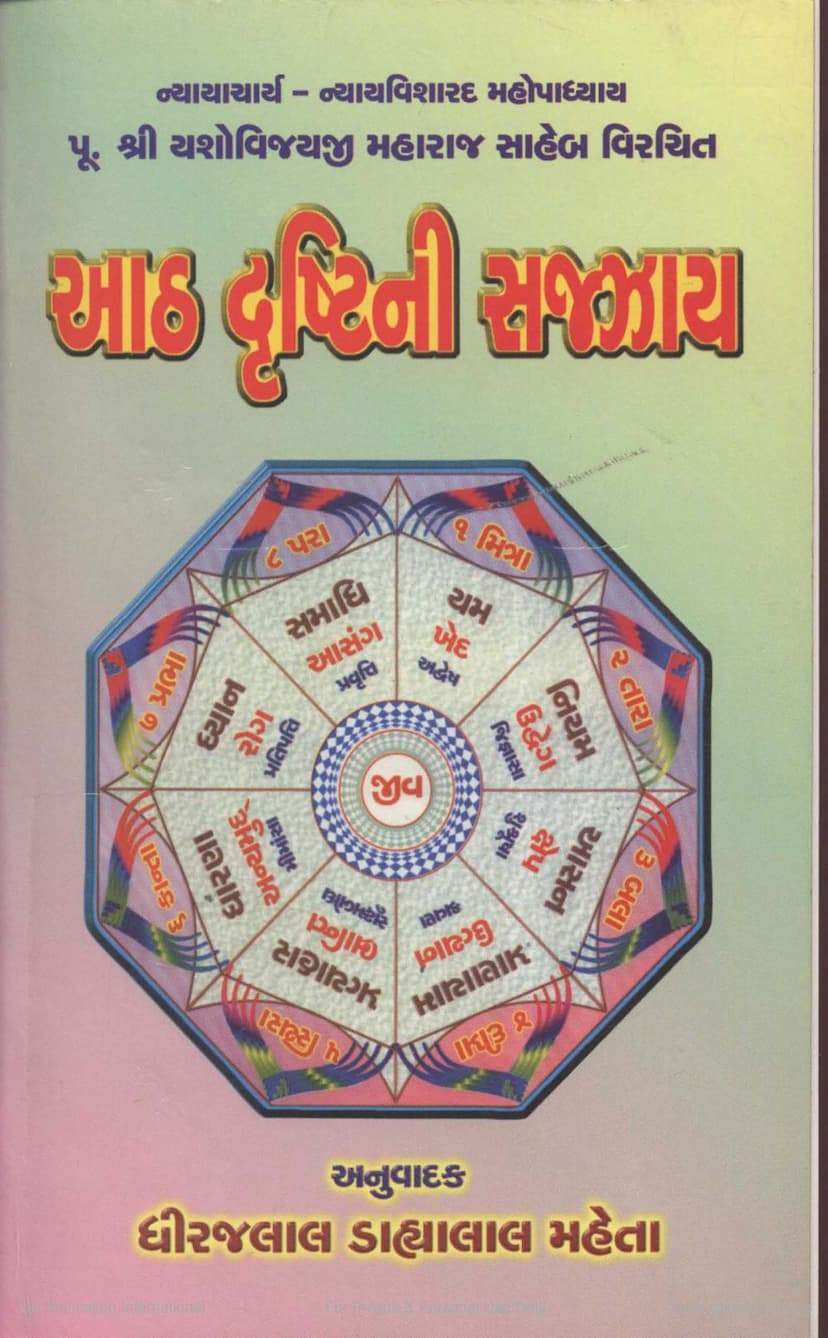Ath Drushtini Sazzay
Added to library: September 1, 2025

Summary
The book "Ath Drushtini Sazzay" by Yashovijay Upadhyay and Dhirajlal D Mehta, published by Jain Dharm Prasaran Trust Surat, is a Gujarati poetic commentary on the "Eightfold Path of Vision" (Ashta Drishti) as expounded in Acharya Haribhadra Surishwarji's Sanskrit work, "Shri Yogdrishti Samuccay."
The core concept of the book revolves around the "eight stages of vision" that an individual progresses through on their spiritual journey towards liberation (moksha) in Jain philosophy. These stages represent a gradual shift in perspective, moving from worldly attachment (Oghdrishti) to spiritual liberation (Yogdrishti).
Here's a breakdown of the eight visions presented in the text:
-
Mitra Drishti (Friend's Vision): This is the initial stage where the soul begins to develop an aversion towards worldly pleasures and a liking for spiritual pursuits and liberation. It marks the beginning of yoga, characterized by reverence for the path to liberation, respect for the enlightened beings (Tirthankaras and Gurus), and the adoption of basic ethical principles like non-violence, truthfulness, etc. The spiritual understanding at this stage is likened to the light of grass catching fire – faint but present.
-
Tara Drishti (Star's Vision): With continued practice, the spiritual inclination deepens. The understanding becomes clearer, comparable to the light of cow dung cakes burning. This stage involves a stronger desire to know and understand the true nature of reality, leading to adherence to disciplines like purity of means for monks and vows for laypersons, as prescribed in Jain scriptures.
-
Bala Drishti (Strength's Vision): As the spiritual understanding strengthens, comparable to the light of wood fire, the soul develops a steadfastness in practice. Minor distractions (Kshepa) are overcome, and the practice becomes more stable (Asana). The desire to listen to spiritual teachings (Shushrusha) grows, leading to a deeper pursuit of knowledge.
-
Deepra Drishti (Lamp's Vision): With the weakening of falsehood (mithyatva) through the previous stages, the vision of reality becomes clearer, like the light of a lamp. This stage involves overcoming external distractions (Utthan) and developing control over breath (Pranayama). The love for Dharma becomes so profound that one is willing to sacrifice life for it, rather than Dharma for life. The understanding of what causes bondage and liberation becomes clear.
-
Sthira Drishti (Stable Vision): This stage marks the attainment of Right Faith (Samyaktva). The spiritual understanding is like the steady light of a gem, free from delusion. With the practice of detachment (Pratyahara), the senses are controlled, and the mind focuses inwards. The understanding of true and eternal spiritual happiness dawns.
-
Kanta Drishti (Pleasing Vision): The understanding here is likened to the light of stars spreading across the sky. The soul is immersed in contemplating profound spiritual truths (Mimansa). The power of concentration (Dharana) strengthens, allowing the soul to retain spiritual knowledge without forgetting. There's a deep contentment and taste for true spiritual knowledge, making worldly pursuits seem insignificant.
-
Prabha Drishti (Radiance Vision): The spiritual understanding now shines like the sun's rays, illuminating all aspects of reality. There's a strong commitment to embodying true principles (Tattva Pratipatti). Constant meditation (Dhyana) becomes a beloved practice. Any physical or mental ailments are overcome through balanced diet and intense practice. The soul experiences a profound inner joy and self-sufficiency.
-
Para Drishti (Supreme Vision): This is the final stage of spiritual perfection. The soul experiences ultimate peace and equanimity (Samadhi). It is characterized by inherent purity, the destruction of all internal enemies (passions and afflictions), and the attainment of supreme knowledge (Kevalgyana). The actions are effortless and naturally aligned with the soul's pure nature. This is the state of liberation.
The book emphasizes the author's profound respect for Acharya Haribhadra Surishwarji and aims to make these high philosophical concepts accessible to all, especially the younger generation. The text also provides a biographical sketch of the author, Yashovijay Upadhyay, highlighting his scholarly achievements and dedication to Jainism. The commentary by Dhirajlal D Mehta aims to further clarify the profound meanings within the Sazzay.